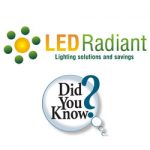Switching to LED
So, you made up your mind and you said to yourself: "I am switching to LED".
A lot of people told you about it, you know and you heard about all the benefits yet you have been procrastinating it for quite a while.
FINALLY, something clicked and you said "ok, it is time", only to find out that it wasn't that easy...Switching to Led: you seem to be loosing the battle.
Nothing is more frustrating than picking up the phone to realize that you know ABSOLUTELY NOTHING about the subject. There are so many new terms, classifications and options that what you though (and should be) an easy task ends up being a mission you are not really sure you will be able to survive…Switching to LED seems to be a nightmare!
Therefore, to make your life easier, LEDRadiant have prepare a series of articles which provide an easy explanation of the things you MUST know beforehand so you can make a swift and fast transition to LED. Believe us when we say: Switching to LED is easy
First: the WHAT
First of all, if you are REPLACING an old lamp, you NEED to know WHAT type of lamp you are replacing. It might be:
- Incandescent: Typical bulb in most residencies up to 15/20 years ago...(is an electric light with a wire filament heated to such a high temperature that it glows with visible light-incandescence-)
- HID (High Intensity Discharge): Mostly on commercial settings, (These lamps replace the filament of a light bulb with a capsule of gas. The light emanates from an arc discharge between two closely spaced electrodes. This discharge is hermetically sealed inside a small quartz glass tubular capsule.) They can be Metal Halide, Mercury Vapor and Sodium Vapor. or
- CFL (Compact Fluorescent Light): Fluorescent tubes are in this category. (In a CFL, an electric current is driven through a tube containing argon and a small amount of mercury vapor. This generates invisible ultraviolet light that excites a fluorescent coating -called phosphor- on the inside of the tube, which then emits visible light.)
Incandescent |
CFLs |
 Incandescent Bulb Incandescent Bulb |
 CFL Lamps CFL Lamps |
HIDs |
|
 HPS Lamps HPS Lamps |
 Metal Halide Lamps Metal Halide Lamps |
So, switching to LED implies 2 things: knowing what to replace and...
Second: WATTAGE
You need to know what’s the wattage of the lamp you want to replace. To find out this, you can read the wattage on the lamp itself (most of the bulbs have this information) or look for the information on the box of a spare one.
As a result, with these two pieces of information, Type and Wattage, it will be easy to determine the equivalent in LED that you need and with this, the switching to LED will be a breeze.
As a general rule, is there any way to calculate the wattage equivalency in LED?
YES!, as a really usufull starter, follow these simple formulas:
- Incandescent: Divide actual wattage by 11
- CFL: Divide actual wattage by 2.5
- HID: Divide actual wattage by 4.5
Examples:
- If you have a 400 Metal Halide (HID) bulb in a high bay, you should replace it with: (400/4.5= 88.88) a 100W LED and this way you will have a little bit more light than what you have now. These are some of the options you could go with when you are looking for replacements when you are switching to LED.
- You have a Fixture that is using a 14W CFL lamp and you want to replace it with LED: 14/2.5=5.6 . So any LED 6 watts an up will be a good fit. You can check here some of them.
- What about replacing that old 150W Incandescent lamp? 150/11=13.63. So starting at 14W you should be good to good! Here are some good replacements for that
Since LED technology is constantly evolving, this is going to give you just an ESTIMATE value, a rough idea of what LED wattage you’ll need to replace the old lamp and switch to LED.
There are other factors to take into account (like height, area to cover, type of light/fixture, etc.) For a more precise evaluation do not hesitating contacting us.
These formulas are an estimate based on an LED technology that generates around 130 lumens per watt. This is a value that raises constantly with technology improvements, hence changing the formula on a regular basis.
That's all for now!
We truly hope this information is helpful for you and, furthermore, helps reducing researching time and ease your switching to LED lighting project.
Since we are here to help, please do not hesitate contacting us for more information or to show you different economical options for your next LED switch.
In our next post we will learn the meaning of some concepts like wattage, types of tubes, Bulb and tubes bases or connectors, and lenses.
Have a wonderful and illuminated week!
















